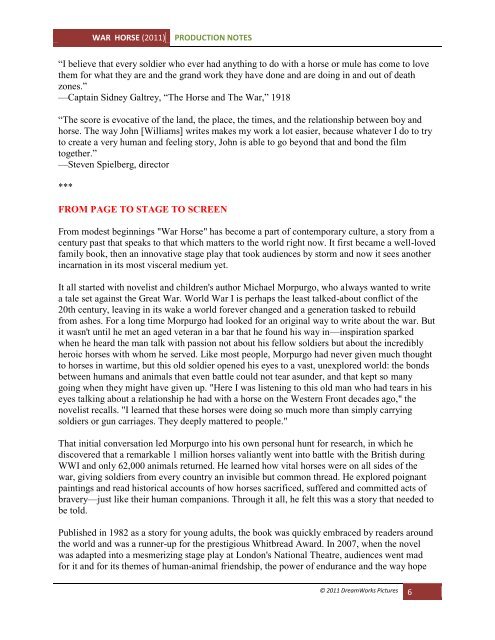WAR HORSE Production Notes
WAR HORSE Production Notes
WAR HORSE Production Notes
Create successful ePaper yourself
Turn your PDF publications into a flip-book with our unique Google optimized e-Paper software.
<strong>WAR</strong> <strong>HORSE</strong> (2011)PRODUCTION NOTES―I believe that every soldier who ever had anything to do with a horse or mule has come to lovethem for what they are and the grand work they have done and are doing in and out of deathzones.‖—Captain Sidney Galtrey, ―The Horse and The War,‖ 1918―The score is evocative of the land, the place, the times, and the relationship between boy andhorse. The way John [Williams] writes makes my work a lot easier, because whatever I do to tryto create a very human and feeling story, John is able to go beyond that and bond the filmtogether.‖—Steven Spielberg, director***FROM PAGE TO STAGE TO SCREENFrom modest beginnings "War Horse" has become a part of contemporary culture, a story from acentury past that speaks to that which matters to the world right now. It first became a well-lovedfamily book, then an innovative stage play that took audiences by storm and now it sees anotherincarnation in its most visceral medium yet.It all started with novelist and children's author Michael Morpurgo, who always wanted to writea tale set against the Great War. World War I is perhaps the least talked-about conflict of the20th century, leaving in its wake a world forever changed and a generation tasked to rebuildfrom ashes. For a long time Morpurgo had looked for an original way to write about the war. Butit wasn't until he met an aged veteran in a bar that he found his way in—inspiration sparkedwhen he heard the man talk with passion not about his fellow soldiers but about the incrediblyheroic horses with whom he served. Like most people, Morpurgo had never given much thoughtto horses in wartime, but this old soldier opened his eyes to a vast, unexplored world: the bondsbetween humans and animals that even battle could not tear asunder, and that kept so manygoing when they might have given up. "Here I was listening to this old man who had tears in hiseyes talking about a relationship he had with a horse on the Western Front decades ago," thenovelist recalls. "I learned that these horses were doing so much more than simply carryingsoldiers or gun carriages. They deeply mattered to people."That initial conversation led Morpurgo into his own personal hunt for research, in which hediscovered that a remarkable 1 million horses valiantly went into battle with the British duringWWI and only 62,000 animals returned. He learned how vital horses were on all sides of thewar, giving soldiers from every country an invisible but common thread. He explored poignantpaintings and read historical accounts of how horses sacrificed, suffered and committed acts ofbravery—just like their human companions. Through it all, he felt this was a story that needed tobe told.Published in 1982 as a story for young adults, the book was quickly embraced by readers aroundthe world and was a runner-up for the prestigious Whitbread Award. In 2007, when the novelwas adapted into a mesmerizing stage play at London's National Theatre, audiences went madfor it and for its themes of human-animal friendship, the power of endurance and the way hope© 2011 DreamWorks Pictures 6


